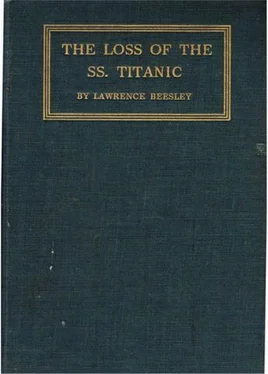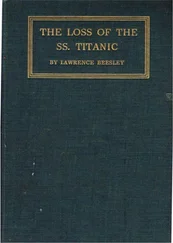There is very little to relate from the time of leaving Queenstown on Thursday to Sunday morning. The sea was calm,—so calm, indeed, that very few were absent from meals: the wind westerly and southwesterly,—“fresh” as the daily chart described it,—but often rather cold, generally too cold to sit out on deck to read or write, so that many of us spent a good part of the time in the library, reading and writing. I wrote a large number of letters and posted them day by day in the box outside the library door: possibly they are there yet.
Each morning the sun rose behind us in a sky of circular clouds, stretching round the horizon in long, narrow streaks and rising tier upon tier above the sky-line, red and pink and fading from pink to white, as the sun rose higher in the sky. It was a beautiful sight to one who had not crossed the ocean before (or indeed been out of sight of the shores of England) to stand on the top deck and watch the swell of the sea extending outwards from the ship in an unbroken circle until it met the sky-line with its hint of infinity: behind, the wake of the vessel white with foam where, fancy suggested, the propeller blades had cut up the long Atlantic rollers and with them made a level white road bounded on either side by banks of green, blue, and blue-green waves that would presently sweep away the white road, though as yet it stretched back to the horizon and dipped over the edge of the world back to Ireland and the gulls, while along it the morning sun glittered and sparkled. And each night the sun sank right in our eyes along the sea, making an undulating glittering path way, a golden track charted on the surface of the ocean which our ship followed unswervingly until the sun dipped below the edge of the horizon, and the pathway ran ahead of us faster than we could steam and slipped over the edge of the skyline,—as if the sun had been a golden ball and had wound up its thread of gold too quickly for us to follow.
From 12 noon Thursday to 12 noon Friday we ran 386 miles, Friday to Saturday 519 miles, Saturday to Sunday 546 miles. The second day’s run of 519 miles was, the purser told us, a disappointment, and we should not dock until Wednesday morning instead of Tuesday night, as we had expected; however, on Sunday we were glad to see a longer run had been made, and it was thought we should make New York, after all, on Tuesday night. The purser remarked: “They are not pushing her this trip and don’t intend to make any fast running: I don’t suppose we shall do more than 546 now; it is not a bad day’s run for the first trip.” This was at lunch, and I remember the conversation then turned to the speed and build of Atlantic liners as factors in their comfort of motion: all those who had crossed many times were unanimous in saying the Titanic was the most comfortable boat they had been on, and they preferred the speed we were making to that of the faster boats, from the point of view of lessened vibration as well as because the faster boats would bore through the waves with a twisted, screw-like motion instead of the straight up-and-down swing of the Titanic. I then called the attention of our table to the way the Titanic listed to port (I had noticed this before), and we all watched the sky-line through the portholes as we sat at the purser’s table in the saloon: it was plain she did so, for the sky-line and sea on the port side were visible most of the time and on the starboard only sky. The purser remarked that probably coal had been used mostly from the starboard side. It is no doubt a common occurrence for all vessels to list to some degree; but in view of the fact that the Titanic was cut open on the starboard side and before she sank listed so much to port that there was quite a chasm between her and the swinging lifeboats, across which ladies had to be thrown or to cross on chairs laid flat, the previous listing to port may be of interest.
Returning for a moment to the motion of the Titanic, it was interesting to stand on the boat-deck, as I frequently did, in the angle between lifeboats 13 and 15 on the starboard side (two boats I have every reason to remember, for the first carried me in safety to the Carpathia, and it seemed likely at one time that the other would come down on our heads as we sat in 13 trying to get away from the ship’s side), and watch the general motion of the ship through the waves resolve itself into two motions—one to be observed by contrasting the docking-bridge, from which the log-line trailed away behind in the foaming wake, with the horizon, and observing the long, slow heave as we rode up and down. I timed the average period occupied in one up-and-down vibration, but do not now remember the figures. The second motion was a side-to-side roll, and could be calculated by watching the port rail and contrasting it with the horizon as before. It seems likely that this double motion is due to the angle at which our direction to New York cuts the general set of the Gulf Stream sweeping from the Gulf of Mexico across to Europe; but the almost clock-like regularity of the two vibratory movements was what attracted my attention: it was while watching the side roll that I first became aware of the list to port. Looking down astern from the boat-deck or from B deck to the steerage quarters, I often noticed how the third-class passengers were enjoying every minute of the time: a most uproarious skipping game of the mixed-double type was the great favourite, while “in and out and roundabout” went a Scotchman with his bagpipes playing something that Gilbert says “faintly resembled an air.” Standing aloof from all of them, generally on the raised stern deck above the “playing field,” was a man of about twenty to twenty-four years of age, well-dressed, always gloved and nicely groomed, and obviously quite out of place among his fellow-passengers: he never looked happy all the time. I watched him, and classified him at hazard as the man who had been a failure in some way at home and had received the proverbial shilling plus third-class fare to America: he did not look resolute enough or happy enough to be working out his own problem. Another interesting man was travelling steerage, but had placed his wife in the second cabin: he would climb the stairs leading from the steerage to the second deck and talk affectionately with his wife across the low gate which separated them. I never saw him after the collision, but I think his wife was on the Carpathia. Whether they ever saw each other on the Sunday night is very doubtful: he would not at first be allowed on the second-class deck, and if he were, the chances of seeing his wife in the darkness and the crowd would be very small, indeed. Of all those playing so happily on the steerage deck I did not recognize many afterwards on the Carpathia.
Coming now to Sunday, the day on which the Titanic struck the iceberg, it will be interesting, perhaps, to give the day’s events in some detail, to appreciate the general attitude of passengers to their surroundings just before the collision. Service was held in the saloon by the purser in the morning, and going on deck after lunch we found such a change in temperature that not many cared to remain to face the bitter wind—an artificial wind created mainly, if not entirely, by the ship’s rapid motion through the chilly atmosphere. I should judge there was no wind blowing at the time, for I had noticed about the same force of wind approaching Queenstown, to find that it died away as soon as we stopped, only to rise again as we steamed away from the harbour.
Returning to the library, I stopped for a moment to read again the day’s run and observe our position on the chart; the Rev. Mr. Carter, a clergyman of the Church of England, was similarly engaged, and we renewed a conversation we had enjoyed for some days: it had commenced with a discussion of the relative merits of his university—Oxford—with mine—Cambridge—as world-wide educational agencies, the opportunities at each for the formation of character apart from mere education as such, and had led on to the lack of sufficiently qualified men to take up the work of the Church of England (a matter apparently on which he felt very deeply) and from that to his own work in England as a priest. He told me some of his parish problems and spoke of the impossibility of doing half his work in his Church without the help his wife gave. I knew her only slightly at that time, but meeting her later in the day, I realized something of what he meant in attributing a large part of what success he had as a vicar to her. My only excuse for mentioning these details about the Carters—now and later in the day—is that, while they have perhaps not much interest for the average reader, they will no doubt be some comfort to the parish over which he presided and where I am sure he was loved. He next mentioned the absence of a service in the evening and asked if I knew the purser well enough to request the use of the saloon in the evening where he would like to have a “hymn sing-song”; the purser gave his consent at once, and Mr. Carter made preparations during the afternoon by asking all he knew—and many he did not—to come to the saloon at 8.30 P.M.
Читать дальше












